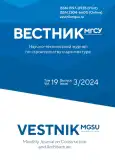Using Building Information Modelling (BIM) by studying building orientation during design to achieve more sustainable buildings
- Authors: Omran J.Y.1, Wassouf M.A.1
-
Affiliations:
- Tishreen University
- Issue: Vol 19, No 3 (2024)
- Pages: 436-455
- Section: Technology and organization of construction. Economics and management in construction
- URL: https://bakhtiniada.ru/1997-0935/article/view/255907
- ID: 255907
Cite item
Full Text
Abstract
About the authors
Jamal Younis Omran
Tishreen University
Email: j-omran@tishreen.edu.sy
ORCID iD: 0000-0002-8429-6210
Moustafa Ali Wassouf
Tishreen University
Email: moustafa.wassouf@tishreen.edu.sy
ORCID iD: 0000-0002-3001-5030
References
- Малков И.И. Энергосбережение в жилищном строительстве. Пассивный и умный дом : учебно-методическое пособие. Гомель : БелГУТ, 2012. 18 с.
- Khudhaire H.Y., Naji H.I. Management of Abandoned Construction Projects in Iraq Using BIM Technology // International Journal of Engineering. 2021. Vol. 34. Issue 3. doi: 10.5829/ije.2021.34.03c.08
- Omran J. How to achieve sustainable building design and operation with building information modeling // Tishreen University Journal for Research and Scientific Studies. 2020. Vol. 42. Issue 2. Pp. 217–232.
- Jalaei F., Jrade A. Integrating BIM with Green Building Certification System, Energy Analysis, and Cost Estimating Tools to Conceptually Design Sustainable Buildings // Electronic Journal of Information Technology in Construction. 2014. Vol. 19. Pp. 140–149. doi: 10.1061/9780784413517.015
- Egwunatum S., Joseph-Akwara E., Akaigwe R. Optimizing energy consumption in building designs using building information model (BIM) // Slovak Journal of Civil Engineering. 2016. Vol. 24. Issue 3. Pp. 19–28. doi: 10.1515/sjce-2016-0013
- Голованова Л.А. Основы проектного управления инвестициями в повышении энергоэффективности зданий // Вестник Тихоокеанского государственного университета. 2017. № 4 (47). С. 193–202. EDN YPJGOZ.
- Watfa M.K., Hawash A.E., Jaafar K. Using building information & energy modelling for energy efficient designs // Journal of Information Technology in Construction. 2021. Vol. 26. Pp. 427–440. doi: 10.36680/j.itcon.2021.023
- Egwunatum S., Joseph-Akwara E., Akaigwe R. Optimizing energy consumption in building designs using building information model (BIM) // Slovak Journal of Civil Engineering. 2016. Vol. 24. Issue 3. Pp. 19–28. doi: 10.1515/sjce-2016-0013
- Alsaud Y.A. Analyze the performance of sustainable buildings using BIM software — Evaluating Simulation Accuracy. Elias Acetic AAA Canaanite, 2019.
- Geekiyanage D., Ramachandra T. A correlation analysis of factors influencing cooling energy demand of condominiums in Sri Lanka // National Energy Symposium 2017. 2017.
- Ayyad T.M. The impact of building orientation, opening to wall ratio, aspect ratio and envelope materials on buildings energy consumption in the tropics. The British University in Dubai (BUiD), 2011.
- Jannat N., Hussien A., Abdullah B., Cotgrave A. A comparative simulation study of the thermal performances of the building envelope wall materials in the tropics // Sustainability. 2020. Vol. 12. Issue 12. P. 4892. doi: 10.3390/su12124892
- Mengana S., Mousiadis T. Parametric BIM: Energy performance analysis using Dynamo for Revit. 2016.
- Thabet W., Lucas J., Srinivasan S. Linking life cycle BIM data to a facility management system using Revit Dynamo // Organization, Technology and Management in Construction: an International Journal. 2022. Vol. 14. Issue 1. Pp. 2539–2558. doi: 10.2478/otmcj-2022-0001
- Prasad K., Anchan S.S., Shambavi Kamath M., Akella V. Impact of building orientation on energy consumption in the design of green building // International Journal of Emerging Research in Management & Technology. 2017. Vol. 6. Issue 2. Pp. 8–11.
- Ashour H. The environmental role of urban system (separate residences) in residential neighborhoods. Aleppo as a case study. Aleppo University Faculty of Architecture, 2014.
- Ibrahim N.A., Elsayed E., Saleh O.M. Towards a contemporary formulation of smart envelopes in the local environment // Engineering Research Journal — Faculty of Engineering (Shoubra). 2022. Vol. 51. Issue 3. Pp. 191–206. doi: 10.21608/ERJSH.2022.252297
- Divin N.V. BIM by using Revit API and dynamo : a review // AlfaBuild. 2020. No. 2 (14). P. 1404. doi: 10.34910/ALF.14.4.EDNCGPPSX.
- Mishra S., Usmani J., Varshney S. Energy saving analysis in building walls through thermal insulation system // International Journal of Engineering Research and Applications. 2012. Vol. 2. Issue 5. Pp. 128–135.
- Cai S., Zhang B., Cremaschi L. Review of moisture behavior and thermal performance of polystyrene insulation in building applications // Building and Environment. 2017. Vol. 123. Pp. 50–65. doi: 10.1016/j.buildenv.2017.06.034
Supplementary files





